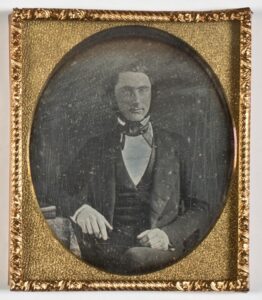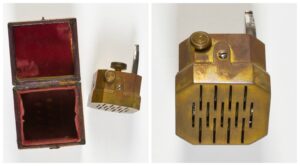Within the vast collections at the American Antiquarian Society there is a particularly interesting assortment of items that offer a unique glimpse into the world of Dr. Nathan Staples Pike, his family, and the medical trade in antebellum America. The Pike-Wright Family collection, donated to AAS by Susan Pike Corcoran, contains Dr. Pike’s early 19th century medical equipment alongside numerous letters, ledgers, journals, and more. A handful of these items are currently on display in the AAS reading room, along with related materials. Looking at these items brings to life the daily activities of Dr. Pike more than just reading words on a page. You can almost see him plucking one of the tools out of his bag while visiting a patient recorded neatly in his ledger.
Born to Isaac Pike and Rebecca Briggs on August 19, 1819, Nathan’s lifelong passion for learning is revealed through the material safely housed in the Pike-Wright Family collection. In 1837, at the age of 18, he began teaching in the Foster Connecticut school district. Two years later, in 1839, Nathan enrolled at the Berkshire Medical Institution in Pittsfield, MA. Leaving school the same year, he first apprenticed with D. W. Hovey and then in 1840 with Dr. William Hubbard while beginning a two-year course of study at New York University. Nathan graduated in 1842 and went on to set up a successful medical practice in central Connecticut.

Though Dr. Pike had completed his medical degree and an apprenticeship, he continued to attend lectures and further his knowledge of the latest innovations to the antebellum medical field. To hear a medical lecture in the first half of the 19th century, matriculated students and the curious public could purchase a ticket to attend and receive credit for their topic of choice. This method allowed physicians to continue their medical education long after earning a degree or completing an apprenticeship. Evident in the twelve lecture tickets found in the Pike-Wright Family collection, Dr. Pike took full advantage of the academic opportunity the ticket system provided throughout his career.
Now a well-established physician, Dr. Pike turned his focus to his personal life. On April 28, 1853, he married Jane Frances Perkins of Sterling, CT. Beginning in December of 1853, the pages of his diary tell us of his daily struggle against a worsening tuberculosis infection, the sad passing of his infant daughter, Jennie, in 1855, and the stillbirth of a second daughter in 1856. Most often noted, aside from the weather, are Dr. Pike’s symptoms, and how he treated the often debilitating symptoms of tuberculosis with opium, diluted calomel (a mercury chloride mineral), and several other common cures of the day. Another medicinal highlight mentioned that would cause some alarm today is deadly nightshade. Dr. Pike writes on February 9, 1855, “…Belladonna is good very good.”
On March 17, 1854, Dr. Pike recorded a conversation he had with William Tenner, who likewise suffered from tuberculosis. Tenner found that travel and the use of opium best alleviated his suffering, two treatment options that Dr. Pike employed himself. Much of the diary reports on Dr. Pike’s trips south to keep up with warmer weather and the many stops to hospitals, medical lectures, and visits to colleagues he makes along the way. An earlier blog post documents Dr. Pike’s experience at a slave auction he attended while in New Orleans. The diary ends just ten days before Nathan succumbed tuberculosis on February 16, 1857.
Included in the display of Dr. Pike’s materials are two 19th-century medical books. While these did not belong to Dr. Pike, they serve as examples of the type of printed materials available to those practicing medicine at that time. The first of these is a diagnosis manual, which helped inform medical students and practitioners to identify known ailments and diseases based on the symptoms presented in their patients. Chapter 18 in Barclay’s 1858 A Manual of Medical Diagnosis explains how to use differences in breathing, speaking, and percussion resonance to determine the condition of a patient’s lungs. Perhaps assisted by the use of a stethoscope, a physician might notice “the breathing is louder on the duller side,” a possible indication of a “tubercular deposit” (Barclay, p. 199).

Accompanying Barclay’s chapter on pulmonary diagnosis is Dr. Pike’s beautifully carved monaural stethoscope. The monaural stethoscope is an invention of French physician René Laennec in 1816, who wished to find a way to listen to a female patient’s heartbeat without placing his ear against the chest. Originally crafted from boxwood, Laennec modeled his stethoscope after a rolled-up quire of paper. The bell-shaped end of Dr. Nathan Pike’s stethoscope amplifies sound to a higher decibel than Laennec’s straight tube design, making it possible to hear a fetal heartbeat. Adding a removable earpiece would prevent damage when Dr. Pike traveled to visit his patients.
The second book on view, Manual of Materia Medica, is an example of a medicinal guidebook used by medical students in the mid-19th century. Preceded by herbals, these guides contain in-depth instruction on the application of the latest medicinal science and are the forerunners to the pharmaceutical drug texts available today. Manuals such as this would have been invaluable references in any doctor’s library. While individual titles are not listed in the “library valued at $100” in Dr. Nathan Pike’s inventory records, it is possible that he owned a medicinal manual such as this.

Among the most curious of Dr. Pike’s tools is a spring-loaded, multi-blade scarificator, first developed in the 17th century and considered a more compassionate bloodletting tool than the earlier lancets and fleams. To use, Dr. Pike would pull back the lever and then push the round button to release the blades inside the device, creating a series of superficial cuts in the patients’ flesh. This intimidating tool was often used in conjunction with a cup adhered by suction to collect the blood, like the small glass cup also found in Dr. Pike’s collection.
If you found this article of particular interest, check out the previous blog posts about the Pike-Wright collected linked below, or come visit us at Antiquarian Hall to see a select number of objects on view in the reading room display cases.
Related posts:
“Time Stands Still in Collection of Family Photographs” by Lauren Hewes
“An Antebellum Physician’s Kit” by Christine Morris
“A broadside of note” by Ashely Cataldo
“Mining the Numbers in a Medical Ledger” by Sande Bishop
“The Medical Education of Nathan Staples Pike” by Sande Bishop
